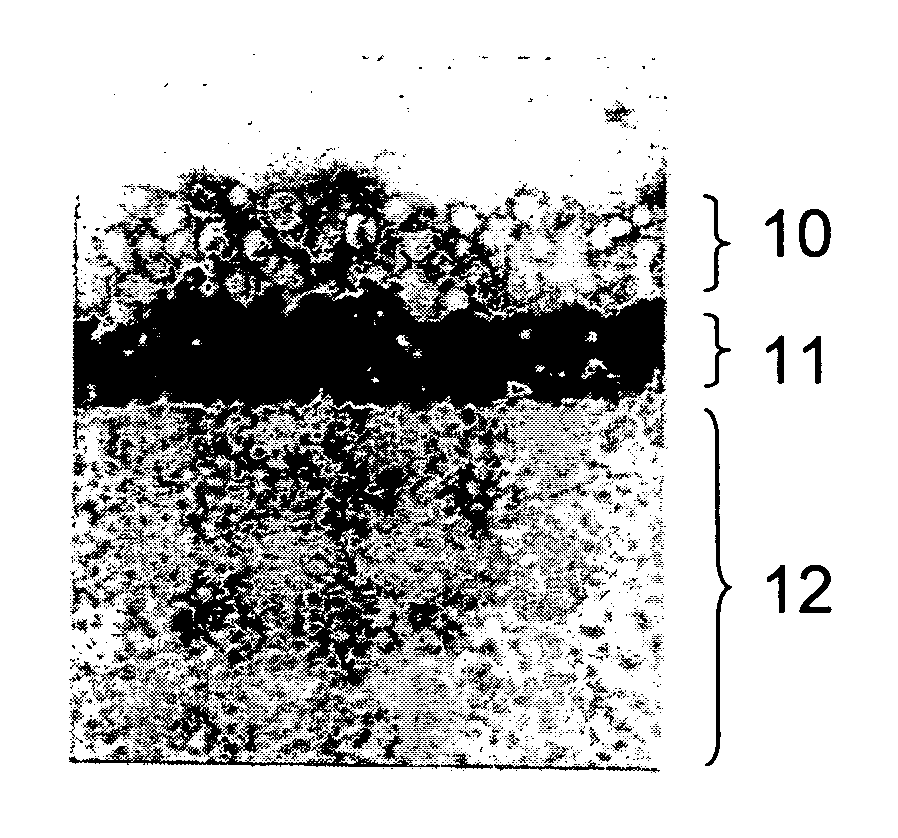Siloxane-Based Coating Material, Optical Article, and Production Method of Siloxane-Based Coating Material
- Summary
- Abstract
- Description
- Claims
- Application Information
AI Technical Summary
Benefits of technology
Problems solved by technology
Method used
Image
Examples
example 1
[0135] At first, 95.2 g (0.7 mol) of methyltrimethoxysilane and 65.4 g (0.3 mol) of trifluoropropyltrimethoxysilane were dissolved in 300 g of propylene glycol monomethyl ether and 100 g of isopropanol. During stirring, 297.9 g of dispersion of silica fine particles having cavities in the inside of outer shells and having a number average particle diameter of 50 nm (isopropanol dispersion, solid matter concentration 20.5%, manufactured by Catalysts and Chemicals Industries Co., Ltd.), 54 g of water, and 1.8 g of formic acid were dropwise added to the obtained solution while the reaction temperature was kept from exceeding 30° C. On completion of dropwise addition, the obtained solution was heated at a bath temperature of 40° C. for 2 hours and thereafter, the solution was heated at a bath temperature of 85° C. for 2 hours and after the inner temperature was increased to 80° C. and heating was continued for 1.5 hours, the solution was cooled to a room temperature to obtain a polymer ...
example 2
[0140] At first, 95.2 g (0.7 mol) of methyltrimethoxysilane and 65.4 g (0.3 mol) of trifluoropropyltrimethoxysilane were dissolved in 300 g of propylene glycol monomethyl ether and 100 g of isopropanol. During stirring, 730 g of sol of silica fine particles having no cavities in the inside and having a number average particle diameter of 12 nm (trade name: IPA-ST, solid matter concentration 30%, manufactured by Nissan Chemical Industries, Ltd.), 60 g of water, and 2 g of formic acid were dropwise added to the obtained solution while the reaction temperature was kept from exceeding 30° C. On completion of dropwise addition, the obtained solution was heated at a bath temperature of 40° C. for 2 hours and thereafter, the solution was heated at a bath temperature of 85° C. for 2 hours and after the inner temperature was increased to 80° C. and heating was continued for 1.5 hours, the solution was cooled to a room temperature to obtain a polymer solution B.
[0141] As an aluminum type cur...
example 3
[0143] At first, 109.0 g (0.8 mol) of methyltrimethoxysilane, 56.8 g (0.1 mol) of heptadecafluorodecyltrimethoxysilane, and 12 g (0.1 mol) of dimethyldimethoxysilane were dissolved in 300 g of diacetone alcohol and 100 g of isopropanol. During stirring, 250 g of sol of silica fine particles having no cavities in the inside and having a number average particle diameter of 12 nm (trade name: MIBK-ST, solid matter concentration 30%, manufactured by Nissan Chemical Industries, Ltd.), 60 g of water, and 2 g of acetic acid were dropwise added to the obtained solution while the reaction temperature was kept from exceeding 30° C. On completion of dropwise addition, the obtained solution was heated at a bath temperature of 40° C. for 2 hours and thereafter, the solution was heated at a bath temperature of 85° C. for 2 hours and after the inner temperature was increased to 80° C. and heating was continued for 1.5 hours, the solution was cooled to a room temperature to obtain a polymer solutio...
PUM
| Property | Measurement | Unit |
|---|---|---|
| Thickness | aaaaa | aaaaa |
| Thickness | aaaaa | aaaaa |
| Particle size | aaaaa | aaaaa |
Abstract
Description
Claims
Application Information
 Login to View More
Login to View More - R&D
- Intellectual Property
- Life Sciences
- Materials
- Tech Scout
- Unparalleled Data Quality
- Higher Quality Content
- 60% Fewer Hallucinations
Browse by: Latest US Patents, China's latest patents, Technical Efficacy Thesaurus, Application Domain, Technology Topic, Popular Technical Reports.
© 2025 PatSnap. All rights reserved.Legal|Privacy policy|Modern Slavery Act Transparency Statement|Sitemap|About US| Contact US: help@patsnap.com



